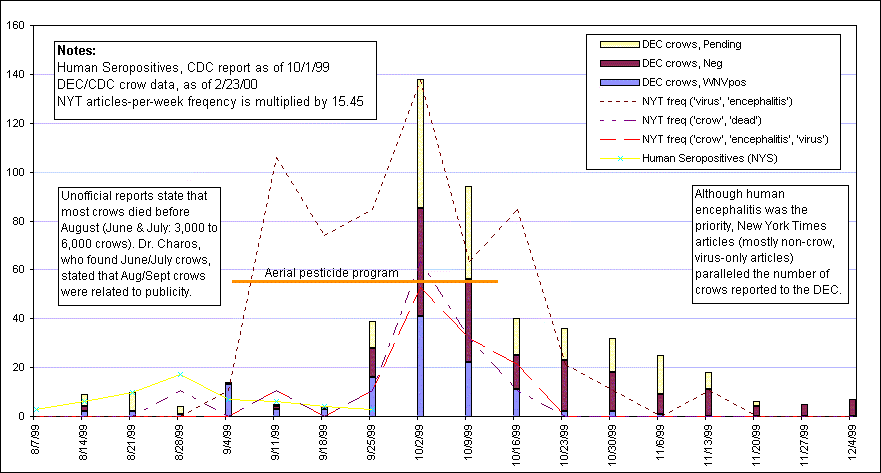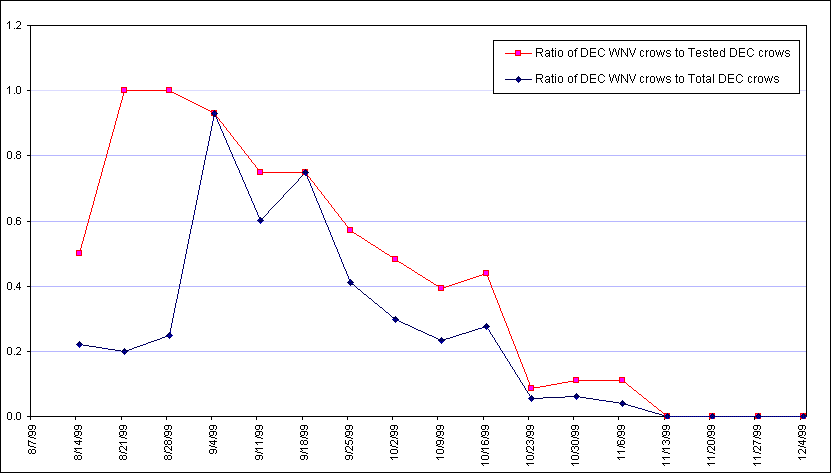Why is the bird epidemic of 1999 important?
The bird epidemic is frequently referred to by all media, news and scientific journals as evidence of the concurrent "natural transmission cycle" of the West Nile virus through birds, mosquitoes and man. The birds, often referred to as "crows" (60% of bird deaths in the DEC WNV database) are officially acknowledged sentinels, sensitive for WNV presence. Their deaths are indicate epidemiological geography and time patterns, before the disease would reach the human population.
Without the bird deaths, an avian/mosquito virus would not have been suspected by the epidemiologists. Other encephalitis viruses such as the enteroviruses (coxsackie, echovirus, poliovirus) would have been tested for. Extreme air-toxics during last summer could have been investigated.
However, about 83-95% of the bird epidemic was omitted from the media and scientific reporting -- those birds that died from late June to through July. Officially, only 5-17% of the bird deaths were acknowledged, confirmed -- those that died during the human epidemic, in August. Omitted, were those birds whose death concurred with arguably the highest levels of air pollution ever to occur in the New York City region.
A spreadsheet database was published by Ward Stone, of the Wildlife Pathology Unit (NYS DEC), dated 2/23/00. It has been summarized graphically. Added to the graph, are interpolated human WNV epidemic data, The New York Times count of articles containing specific words, and a time bar representing the aerial pesticide spray program:

Geographical Distribution: Bird death was reported from all over NYC and LI, yet the human epidemic was limited to NW Queens and SE Bronx, where there was also a high bird death density (DEC, news, and CDC sources). The primary areas were Whitestone (NW Qns), College Point (NW Qns), Bayside (NW Qns), and SE Bronx.
Infection Date: Dead birds were often found in decomposed state. They had often been dead for while, making onset dates difficult to determine.
Media/Bird Interaction: West Nile virus articles (bird related and, to an even greater extent, non-bird related) seem to be follow the number of reported birds, and, conversely the number of reported birds was driven by the media drama. Officially, the normal sequence should have been detection of the virus in mosquitoes, then bird deaths, and lastly human deaths.
Pre-August Bird Epidemic: Dr. Charos, the veterinarian who treated NW Queens crows, stated that the late-August and onward bird death reports were the result of tremendous media play and that the epidemic of dying crows actually occurred June and July. He stated that mid-July was the peak bird death rate and that the dead crows were almost all young crows. An NYSDOH memo states that over 3,000 crow deaths were reported to the NYSDOH and left unconfirmed. Of the mostly August-onward animals reported to DEC and tested for WNV, 60% were crows (312 of 520), almost entirely American Crows (304). There were 8 Fish Crows.
Results
Ratios Graph
The Tail End Of A Major Epidemic?

Considerations/Critique
Concurrence: Though unconfirmed bird deaths were occurring at much greater numbers in June/July, the West Nile virus is shown in NYSDEC database as first found in birds at the same time that human encephalitis victims began filing into Flushing Hospital (Queens). The first officially recognized WNV positive crow was found 8/11/99 and the first patient to arrive at Flushing hospital was 8/12/99.
Farr's Law: According to Farr's Law, which states that germ epidemics should grow exponentially, WNV appears in the chart above (Results Ratios), in terms of bird virus analysis, to have appeared almost instantaneously and died away in a linear fashion. The database contains the date found, not the actual date of WNV infection. Many birds were decomposed when found, with most birds being reported August onward. Obviously, the chart represents the end of a much larger epidemic that spanned the summer, and included the June/July bird deaths.
Reporting Procedures: From the NYC region, dead birds are usually not reported to the DEC, according to Ward Stone. Possibly the various NYC regional agencies do not habitually pass along reports of bird deaths to the NYSDEC either. The NYSDEC does not usually get reports direct -- they are referred by other agencies, which the public is more aware, like the Health Department, Fire Department, or Police Department.
Pre-August 1999 Bird Deaths: Only 7 birds (no crows in this early list, however), found from April through July 1999, were tested for WNV and none were found positive for WNV. Except for one Rock Dove from Brooklyn, these birds were found in Manhattan and had previously been presumed intentionally poisoned with pesticide laced feed. No birds from the encephalitis epicenter (Queens and Bronx) were tested. Thus, WNV existence in the "crow epidemic" of June and July is an open issue. There is nothing to prevent us from assuming that the June/July birds also carried WNV -- or that birds always would have tested positive for the WNV in the U.S. -- especially during periods of high smog levels.
Distribution: Dead birds were found everywhere throughout Long Island and New York City, according to the NYSDEC. If birds are part of the transmission cycle, as is stated by CDC, then the WNV must also have been prevalent throughout Long Island and New York City. Why then, were human deaths found only in areas of highest air pollution? The "common thread" among the 7 encephalitis fatalities was that they were elderly, minor health problems, outdoors types, who had no recent travel out of the area. The NYCDOH later (May, 2000) stated that 4 of the 7 had serious health problems: 3 of the 7 patients who had died were on immunosuppressant drugs for cancer and one was HIV positive, i.e., weakened elderly persons, with a maximum intake of air neurotoxins.
Toxicology Not Funded: The NYSDEC has no capability to investigate air toxins as a cause of death for birds. According to Ward Stone, the NYSDEC pathologist, this is impossible, presently and in the future, because the NYSDEC lacks the necessary funds.
Smog: New York City is one of the most highly polluted regions in the U.S., where its atmosphere contains high levels of neurotoxins: ground level ozone, MTBE, and aromatic nitros. These chemicals are each capable of causing encephalitis, some at very low dosages, and with the action of sunlight, can interact to form photochemical smog, a highly poisonous synergistic air toxin. Within New York City, the most polluted areas are South Bronx, NW Queens, and Staten Island. 1999 was the most polluted summer in decades for New York City. The epicenter of the epidemic of bird and human death occurred in the most polluted areas, near a confluence of 5 expressways in NW Queens, downwind from the Bronx and the La Guardia Airport.
During the summer of 1999, the EPA was negotiating with industry to lower emissions, without success (NYT). The neurotoxin, MTBE was approximately 11% of every gallon of gasoline. MTBE was banned by NYS legislature after the summer of 1999, to go into effect 2004, giving industry time to phase MTBE out. At the same time, President Clinton called for a ban of MTBE. Previous to this, few had heard of MTBE, which had been instituted in RFG (reformulated gasoline) at high percentages in the NYC area since 1995, ostensibly to improve the environment by improving emission characteristics. There are strong doubts that it has any environmental virtues, but it is an economic boon to the petroleum industry, as MTBE is manufactured from refinery waste products. MTBE has been under attack by critics who describe it as a neurotoxin that adds to ozone production in photochemical smog. (www.oxybusters.org)
Toxicology Omitted: It clearly appears that there has been no investigation into the relation between air pollution and the West Nile epidemic.
Within the public domain, why was air pollution not considered, at the least, as a cofactor to the West Nile virus epidemic? Why were June/July bird deaths and their close relation to the record high pollution not considered or investigated?